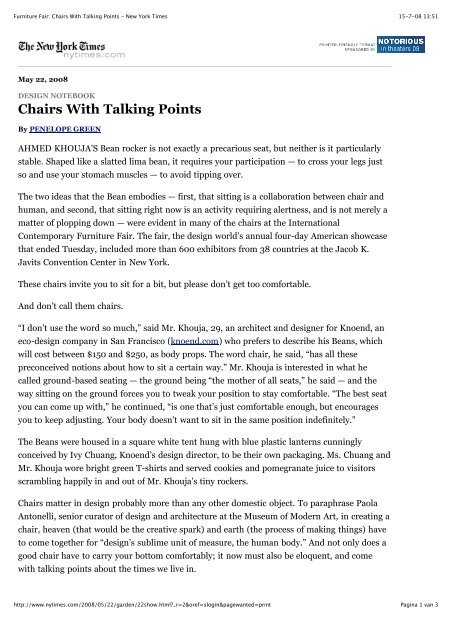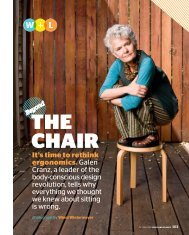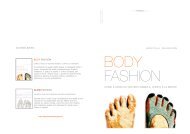Chairs With Talking Points - Body Conscious Design
Chairs With Talking Points - Body Conscious Design
Chairs With Talking Points - Body Conscious Design
Create successful ePaper yourself
Turn your PDF publications into a flip-book with our unique Google optimized e-Paper software.
Furniture Fair: <strong>Chairs</strong> <strong>With</strong> <strong>Talking</strong> <strong>Points</strong> - New York Times<br />
15-7-08 13:51<br />
May 22, 2008<br />
DESIGN NOTEBOOK<br />
<strong>Chairs</strong> <strong>With</strong> <strong>Talking</strong> <strong>Points</strong><br />
By PENELOPE GREEN<br />
AHMED KHOUJA’S Bean rocker is not exactly a precarious seat, but neither is it particularly<br />
stable. Shaped like a slatted lima bean, it requires your participation — to cross your legs just<br />
so and use your stomach muscles — to avoid tipping over.<br />
The two ideas that the Bean embodies — first, that sitting is a collaboration between chair and<br />
human, and second, that sitting right now is an activity requiring alertness, and is not merely a<br />
matter of plopping down — were evident in many of the chairs at the International<br />
Contemporary Furniture Fair. The fair, the design world’s annual four-day American showcase<br />
that ended Tuesday, included more than 600 exhibitors from 38 countries at the Jacob K.<br />
Javits Convention Center in New York.<br />
These chairs invite you to sit for a bit, but please don’t get too comfortable.<br />
And don’t call them chairs.<br />
“I don’t use the word so much,” said Mr. Khouja, 29, an architect and designer for Knoend, an<br />
eco-design company in San Francisco (knoend.com) who prefers to describe his Beans, which<br />
will cost between $150 and $250, as body props. The word chair, he said, “has all these<br />
preconceived notions about how to sit a certain way.” Mr. Khouja is interested in what he<br />
called ground-based seating — the ground being “the mother of all seats,” he said — and the<br />
way sitting on the ground forces you to tweak your position to stay comfortable. “The best seat<br />
you can come up with,” he continued, “is one that’s just comfortable enough, but encourages<br />
you to keep adjusting. Your body doesn’t want to sit in the same position indefinitely.”<br />
The Beans were housed in a square white tent hung with blue plastic lanterns cunningly<br />
conceived by Ivy Chuang, Knoend’s design director, to be their own packaging. Ms. Chuang and<br />
Mr. Khouja wore bright green T-shirts and served cookies and pomegranate juice to visitors<br />
scrambling happily in and out of Mr. Khouja’s tiny rockers.<br />
<strong>Chairs</strong> matter in design probably more than any other domestic object. To paraphrase Paola<br />
Antonelli, senior curator of design and architecture at the Museum of Modern Art, in creating a<br />
chair, heaven (that would be the creative spark) and earth (the process of making things) have<br />
to come together for “design’s sublime unit of measure, the human body.” And not only does a<br />
good chair have to carry your bottom comfortably; it now must also be eloquent, and come<br />
with talking points about the times we live in.<br />
http://www.nytimes.com/2008/05/22/garden/22show.html_r=2&oref=slogin&pagewanted=print<br />
Pagina 1 van 3
Furniture Fair: <strong>Chairs</strong> <strong>With</strong> <strong>Talking</strong> <strong>Points</strong> - New York Times<br />
15-7-08 13:51<br />
The chair of the moment, the plastic cantilevered Myto (about $440, from icfsource.com),<br />
which has been making the rounds of Europe’s furniture fairs, is described by its designer,<br />
Konstantin Grcic, as being shaped like an animal about to pounce. Its handlers were offering<br />
Myto-abilia — a Myto magazine and an adorable Myto miniature that fits in the palm of your<br />
hand — to an audience that included Adam Glassman, creative director of O, the Oprah<br />
magazine. He climbed onto the stage where the chairs were displayed and sat in a deep-plumcolored<br />
version, his eyes squinting in the hot lights. “I’ve been looking for something that’s out<br />
of the box,” he said approvingly.<br />
Brent White, who calls himself an objectologist, also imagines animated furniture. His<br />
critterlike Kunigi Unus ($1,000 each) do seem ready to scramble off on their own. Fashioned<br />
as possum-size footed pods, with a knobby appendage on the front and a hole at the back, they<br />
are designed to fit together like children’s beads, and be sat upon like a small, fat pouf. “I<br />
wanted to create a relationship between the objects themselves that I’m not a part of,” said Mr.<br />
White, whose San Francisco company is called Impeti (impeti.com). “I like the idea that when<br />
you leave your apartment, your couch and your chair might talk about you, and when you come<br />
home at night you might look around and think, Hmm, there’s something different here.”<br />
Mr. White was inspired by the Italian designer Andrea Branzi, whose mid-1980s series, called<br />
Domestic Animals, conceived of furniture as pets, though Mr. Branzi’s “animals” — all animal<br />
hide and prickly wood — seemed barely tamed. The soft-foam Kunigi — the word is Esperanto<br />
for unite, Mr. White said — you just want to cuddle.<br />
Stefan Knox’s LoJoBalls are the children of poufs and beanbag chairs, he said. Perch on them<br />
when the night is young, and unzip them as your energy flags. Filled with two inflatable<br />
pouches, they will support your back the way a pouf never can, and with less mass than a big<br />
squashy beanbag ($120 to $150; lojoballusa.com).<br />
<strong>Body</strong> architecture is another way designers talk about their furniture. A massive aluminum club<br />
chair, padded with vinyl that looked like pebbled steel, recalled the early stages of Iron Man’s<br />
carapace. “People call it the Captain Kirk chair,” said its designer, Bilhenry Walker, who is from<br />
Milwaukee, “because it looks like it’s going to take off. It’s a flyer. Someone said, it looks like it<br />
belongs in the Space Age. I said, Honey, this is the Space Age.” For his part, Mr. Walker calls it<br />
simply Sofa Chair ($14,000; bilhenrygallery.com).<br />
Laurie Beckerman’s white tête-à-tête rocker ($11,000; lauriebeckerman.com) looks and works<br />
like a seesaw: sitting in it becomes a partnership between you and another. When Ms.<br />
Beckerman began working on her first prototype last year, which she made from plywood<br />
lacquered white to look like Corian, she started to see tête-à-têtes everywhere, she said. “There<br />
was a steel one, horribly uncomfortable and made by a man, of course, but I didn’t let it freak<br />
me out.” This year, Ms. Beckerman brought back her rocker, made this time in actual Corian.<br />
A chair can be both problem and solution. Nick DeMarco’s XS chair, the winning candidate in a<br />
studio at the California College of the Arts sponsored by Bevara <strong>Design</strong> House and<br />
Walmart.com, is made from end-roll scrap vinyl. Mr. DeMarco stuffed his with empty Vitamin<br />
http://www.nytimes.com/2008/05/22/garden/22show.html_r=2&oref=slogin&pagewanted=print<br />
Pagina 2 van 3
Furniture Fair: <strong>Chairs</strong> <strong>With</strong> <strong>Talking</strong> <strong>Points</strong> - New York Times<br />
15-7-08 13:51<br />
Walmart.com, is made from end-roll scrap vinyl. Mr. DeMarco stuffed his with empty Vitamin<br />
Water bottles and paper trash, but his idea is that you fill it with whatever you like. It might be<br />
for sale at walmart.com sometime this summer, for about $60. By e-mail, Mr. DeMarco, who is<br />
21, explained that one of his goals for the project had been to highlight the “negative aspects of<br />
Wal-Mart/mass consumer disposable culture” and that he was still conflicted about making a<br />
product to be sold by the big box giant; if he demurs, Bevara (bevaradesigncom) will sell the<br />
chair. “It’s been something I’m still mulling over a lot,” Mr. DeMarco said, “but ultimately I<br />
think it is a positive thing for its potential to reach an audience that is not all that greenminded<br />
yet.”<br />
The most eloquent seating encouraged you to not really sit at all. Maruja Fuentes, a Puerto<br />
Rican designer (marujafuentes.com), has made what she calls leaning molds, which are molded<br />
plastic elbow shelves that fit together like a puzzle and are intended to be used in public spaces<br />
like bus stops. for folks to lean up against, the way a cowboy leans against a stile.<br />
And three young New York designers who call themselves Rich, Brilliant, Willing (for Theo<br />
Richardson, Charles Brill and Alexander Todd Williams) presented Perch, which was shown<br />
downtown at Kiosk on Spring Street (kioskkiosk.com). Kiosk is a highly curated, satisfyingly<br />
obsessive temple of ordinary objects like pencils, manila envelopes, a tin of Mentholatum, a<br />
dinged-up stepping stool, which this week surrounded Perch, an assemblage of PVC tubing and<br />
copper pipes ($1,700 at Kiosk or richbrilliantwilling.com).<br />
“It’s a transient spot, a temporary resting place,” said Mr. Richardson, who explained that<br />
Perch was based on the way Excel spreadsheets display information. “We continue to be<br />
inundated by all sorts of visual data, so it’s a response to that, and it is meant to appropriate<br />
that, too.”<br />
To me, Perch looked more like a Tinkertoy, and it felt like a fence rail, not totally<br />
uncomfortable but definitely not an object to hunker down with.<br />
Copyright 2008 The New York Times Company<br />
Privacy Policy Search Corrections RSS First Look Help Contact Us Work for Us Site Map<br />
http://www.nytimes.com/2008/05/22/garden/22show.html_r=2&oref=slogin&pagewanted=print<br />
Pagina 3 van 3






